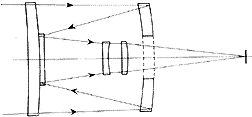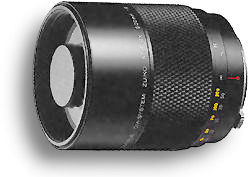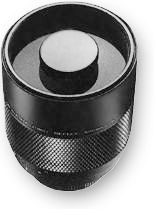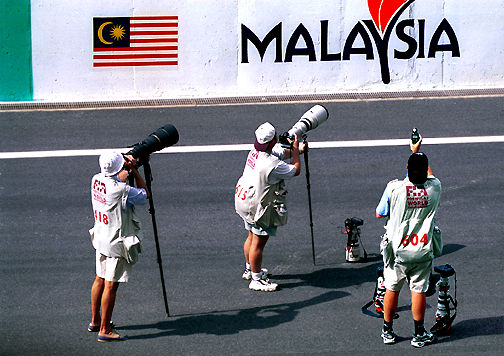There is only one lens at
the 500mm focal length for you to consider in the Zuiko lens series. In fact,
up to the stage where OM2 was officially introduced, Olympus Zuiko lens series
does not provide any option for a Mirror lens. It was not exactly an normal
telephoto lens which you can play around with depth of field control via open
up or stopping down the aperture diaphragm in the lens because it is a fixed
aperture CAT (catadioptric)
lens or more popularly
known as a mirror lens. This lens also remains as the sole Mirror lens within
the entire Zuiko lens family.
The Zuiko Reflex 500mm f/8
lens has a catadioptric design. The image first strikes a mirror and is
reflected forward to a second mirror and group of lenses. The second group
reflects the image back through an opening in the first mirror to the film.
 |
The great
advantage of this type of lens is size. Designers can create a
lens half
the size of a
conventionally designed super telephoto lens type by using the mirror
concept. However, the main drawback for reflex-type lens is it
usually restricted to only a single working aperture; you have
control exposure with varying shutter speed or using neutral density
filter(s). |
Another distinctive
advantage of Mirror lens is, as the optical light path is using a 'light
folding' principle and thus color correction is not necessary with this lens,
common aberrations closely associated with super telephoto lenses such as
chromatic aberration does not exist in such an reflex optical design. Many
seasoned photographers jokingly referred to such lens type as a poor man's
Flurite/ED/LD/UD lens.
OFF
TOPIC Supplements:
When
light passes through a prism and is split into seven colors. The difference in
the refraction index results in dispersion of the various wavelengths as light
passes through a lens. This is called "chromatic
aberration
". In practical terms, it adds up to loss of image sharpness and low
contrast is one of the main phenomenon of this aberrations Optical designers
solve this problem of chromatic aberration by using various types of glass
made to extremely critical refractive indexes while also having low dispersion
properties. Using conventional optical glass, designers can only correct
chromatic aberration only to a certain extent. There remains a residual color
error called the secondary spectrum. With optical glass, this secondary
spectrum cannot be reduced beyond 0.002mm times the focal length. Thus,
secondary spectrum becomes a serious problem as focal length increases.
Lens designers are constantly at work to produce raw materials and new designs
resulting in optical glass with lower refractive indexes and abnormally low
dispersion. Canon developed their own "Artificially" grown fluorite
crystals derived from calcium fluoride while others use specially developed
glass such as ED/LD/UD etc. * fluorite element as well as UD glass and the
other with " UD " (Ultra-Low Dispersion" or
called "ED" (Extra-Low Dispersion) or "SD"
(Super-Low dispersions by many other optical glass manufacturers) glass. Both
types provide images unusually free from chromatic aberration that often
affects the performance of long focal length lenses. Reflex lens with mirror
design does not have chromatic aberration and often used as a cheap high
performance ED lens.
 |
Zuiko Reflex
500mm
F8
Makes possible the interesting creative effects of the reflex type
lens, while also affording fantastic compactness and portability in
this powerful super telephoto length. Image quality is constant even
at close focus distances. Internal coating on the barrel minimizes
flare.
|
The Zuiko Reflex lens is
quite unusual to omit a useful and cheaper to use drop-in type filter or back
screw-in filter design. Instead, a front mounting 72mm is used. I am not so
sure whether it comes with the five color correction and neutral density
filters which usually come with the package with such a lens. So, it is better
to double check this especially when you intend to purchase a unit from any
used outlet.
Aperture: Remember, the lens
has no aperture diaphragm, because of catadioptric type. To decrease the
transmission of light in this lens system, use neutral density filters, which
gives the brightness corresponding to one of the following f-numbers:
Denomination & Equivalent f-number: ND 2.5x = 8; ND 3.2x = 9; ND 4x = 10;
ND 5x = 11; ND 6.3x = 12.5
Note:
Since there is no aperture to control, while the focal length of the lens is
fixed, naturally depth of field cannot be adjusted in this catadioptric
system. (Other than closing in or getting further away from the lens).
|
Reserved
Sample image 1
|
Reserved
Sample image 2
|
Reserved
Sample image 3
|
Reserved
Sample image 4
|
Reserved
Sample image 5
|
N O T
E: As no
photographer in the world would possess ALL the lenses within a single trade
name. You are always encouraged to replace these reserved slot for sample
images above shooting with a lens type detailed above - just mail in your
creative visual, a little caption relative to the background information will
help a lot to let other understand how you prepared the shot. Please mention
IF you require a complimentary link and where should it be pointed at.
Naturally,
I
DO
NOT
like to disappoint anyone, but in order to maintain my self-set standard in
the PIM website - I would prefer to have high quality input rather than
in quantity, if your image is NOT selected for broadcasting in this site, give
it a try the next time but I do promise every image will be view and consider
carefully. I do appreciate your consideration in this matter.
Generally, any lenses at
this 500mm focal length lens can be considered challenging to use. Its 5‘
angle of view encloses the subject tightly within the 35mm frame.
 |
Comparatively, 500mm
lenses with Mirror design are lightweight enough to be used for
handheld photography, however, do not attempt to challenge that if
the light level is not favorable or if you are using slower speed
films. Some form of support is essential to provide added insurance
against movement as the long focal length will magnify greatly into
your images.
|
Another characteristic of a
Mirror lens is, any out-of-focus highlights which render as a doughnut or ring
shape which you will never find in any other type of lens. With a mirror lens,
it is important to anticipate the action and pre-focus for action based or
wildlife pictures. Because of the extremely narrower angle of view, coupled
with the dimly lit viewfinder image due to the single aperture f/8.0, framing
and manual focusing on the action as it actually happens is difficult.
|

|
As there is no clear
definition or restriction of how the lens should be used,
interestingly enough, the 500mm can be even used as a portrait lens.
However, one important portrait technique that you must keep in mind
is to focus precisely and maintain stability at all time.
<<<<<<----
Sample 1 (38k
Jpeg)
|

<<<<<<----
Sample 2
(28k
Jpeg)
|
The 500mm is also an unusual
landscape lens, particularly when dealing with horizons or mountains. The
compressed perspective of this focal length will always yield results in
spectacular images.
Specification:
Lens type: Zuiko 500mm f/8.0 Reflex
Optical Construction: 5 elements in 2 groups
Angles of view: 5‘
Distance Scale: (m) 4 (13.1ft) to infinity (OO)
Focusing: Revolving Helicoid
Minimum aperture: Fixed at f/8. ND filter is used for adjusting light
volume. No depth of field scale.
Diaphragm: Automatic
Filter Type. 72mm
Length: 97mm
Weight: 590g
(20.8oz)
| Previous
| Next
| Zuiko 600mm and 1000mm
super telephoto lenses
|
Back
|
Index Page of OM Zuiko Lenses





